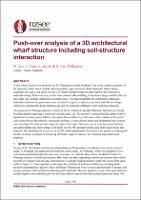Push-over analysis of a 3D architectural wharf structure including soil-structure interaction

Download
Date
2021-04-14Authors
Lei, Weikuang
Vink, Alex
Storie, Luke
Van Ballegooy, Sjoerd
Metadata
Show full item recordAbstract
A new wharf structure was proposed for Te Wānanga in central Auckland. Due to the complex geometry of the proposed wharf, which included plan irregularity, open apertures, deck-suspended planter boxes, suspended nets and a step down in level, a 3D finite element model was developed for the structure to undertake design. Push-over analysis that incorporated both modelling of non-linear hinges and the effect of non-linear soil-structure interaction was undertaken. This paper highlights the collaborative approach undertaken between the geotechnical and structural designers to achieve a practical and efficient design solution by detailing the design methodology and the technical challenges in the modelling approach.
The proposed Te Wānanga structure consists of bored reinforced concrete filled steel tube piles of varying founding depths supporting a reinforced concrete deck slab. The spatially varying founding depths result in significant variation in pile stiffness. To capture the non-linearity of the stress-strain relation of the soil as well as the effect of the spatially varying pile stiffness, a series of non-linear load-deformation (p-y) curves were developed for each soil unit along the depth of the piles. These p-y curves were then converted into uncoupled lateral non-linear springs to be input into the 3D structural model using multi-linear elastic link elements. By modelling the p-y curves in the 3D model, programme efficiencies were gained by reducing the number of design iterations of soil spring stiffnesses required between the structural and geotechnical engineers.
